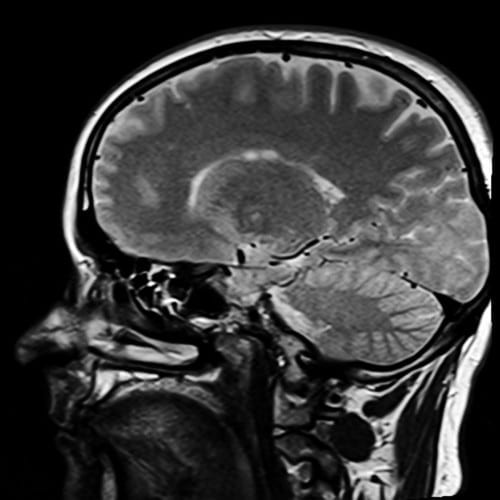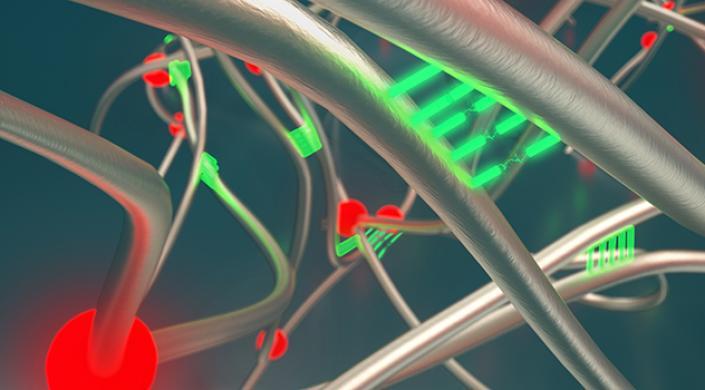
Scientists hopeful for applications in people
A revolutionary gene therapy developed in Colorado could relieve people’s chronic pain, such as arthritis or fibromyalgia but first, it is being tested on pets with incredible results.
A Lafayette veterinarian is using cutting-edge research to heal dogs.
It may not look like it when 9-year-old Amos, a Labrador Retriever mix, is running happily after the ball, but he has arthritis, bad.
His owner, Vicki Riedel knew immediately.
“He is always by my side,” said Riedel. “When I would go outside or downstairs,and he wouldn’t come with me, I knew he was really hurting.”
Their vet tried one medication after the next.
“And they all helped a little bit, but none of them really helped a lot, and he seemed to be getting worse and worse,” said Riedel.
But a few weeks ago, Amos met pet pain specialist Dr. Rob Landry.
“Amos has a history of chronic pain in both his elbows,” said Landry, a Lafayette veterinarian who has been testing a breakthrough gene therapy for chronic pain for the last two years.
“It’s amazing,” said Laundry with a smile.
He’s injected 9 dogs, and so far he said the results speak for themselves.
In cell phone phone video of one dog before the injection, she hops with both back legs because of hip pain.
Just a week post-injection, she uses both legs.
And two months after, her owner said she is a different dog.
“I got into the field of pain to see these changes happen,” said Landry.
“It’s frankly revolutionary,” said Dr. Linda Watkins, who runs the neuroscience program at the University of Colorado. She started a biomedical company that makes the breakthrough therapeutic.
“It went from basic science, to ‘Wow! We got a shot at this,'” said Watkins.
Watkins said that in people with chronic pain, a type of immune cell in the spinal cord gets agitated, releasing signals that amplify pain.
Injecting her therapeutic creates a protein called Interleukin-10 (IL -10), which both dogs and humans produce naturally, and it seems to calm the agitated cells and reduce pain.
In testing on lab rats, it has been effective, but the work on dogs brings new hope.
“It’s not a rat thing. That we see it in the dogs and the dogs have pain relief for three months just like the rats did is really giving me hope that it’s going to translate all the way to people,” said Watkins.
So, the cutting-edge research helping man’s best friend could soon help man. Human clinical trials start in a year.
For pets, the timeline could be much shorter — if the research stays this positive, Landry believes it could be developed for vets within the next year or two.
The Latest Bing News on:
Chronic pain
- Woman suffering chronic pain killed herself after years on surgery waitliston May 1, 2024 at 10:37 pm
A Westbury woman suffering chronic pain and who had spent four years waiting for a total knee reconstruction killed herself after her surgery was cancelled for the third time, a coroner's inquest has ...
- Burning Nerves and Acupuncture: Surprising treatments for chronic back painon May 1, 2024 at 9:02 am
When back pain strikes, you might not think of treating it with more pain. But that's what a growing number of people are doing turning to acupuncture where small needles are injected into trigger ...
- Few Quick Fixes For Low Back Painon April 30, 2024 at 7:26 am
Cases of low back pain are increasing substantially. One in 13 people experienced it in 2020, a 60% increase over 30 years. A key reason is that populations are getting older. It’s in older people ...
- Federal Money To Support Research On Psychedelics As Alternative To Pills For Chronic Pain Among The Elderlyon April 29, 2024 at 10:54 am
The National Institutes of Health (NIH) recently said it will fund clinical trials on examining the safety and efficacy of psychedelic-assisted therapy in older adults with chronic pain. According to ...
- Welcome to a world where we can cure blindness, chronic pain and neurological diseases with 3D printed surgical implantson April 29, 2024 at 10:29 am
Science X is a network of high quality websites with most complete and comprehensive daily coverage of the full sweep of science, technology, and medicine news ...
- Hartford Healthcare: How occupational therapists can help with chronic painon April 29, 2024 at 6:57 am
Occupational therapists have an important role in helping people return back to their day to day life post treatment or surgery. For those suffering from chronic ...
- A Predictive Healthcare Visionary Is Optimistic About Solving America’s Opioid Addiction And Chronic Pain Epidemicon April 26, 2024 at 2:20 pm
Studies found that Chronic pain is more prevalent and costly than cancer, diabetes, and heart disease combined, and its rates are rising even as other chronic ...
- Scientists Make Breakthrough in Chronic Pain Treatmenton April 26, 2024 at 7:53 am
Scientists have developed tiny robotic nerve "cuffs" to diagnose and treat neurological disorders. The flexible devices offer a safer, minimally invasive alternative to today's diagnostics and could ...
- Depression linked to chronic pain: Variability shown across patient characteristicson April 23, 2024 at 5:31 am
Chronic pain is a major global disability cause, affecting over 30% of the population and often coexisting with depression, which disables roughly 5% of adults worldwide. The relationship between ...
- Chronic pain linked to socioeconomic backgroundon April 22, 2024 at 8:59 am
Development of chronic musculoskeletal pain can be influenced by socioeconomics, fear of movement, smoking and poorer support networks, new research shows.
The Latest Google Headlines on:
Chronic pain
[google_news title=”” keyword=”Chronic pain” num_posts=”10″ blurb_length=”0″ show_thumb=”left”]
The Latest Bing News on:
Gene therapy for pain
- Gene therapy treatment increasing body's signal for new blood vessel growth shows promiseon May 2, 2024 at 8:01 am
Final 12-month data from the EXACT trial demonstrates safety and efficacy results for a vascular endothelial growth factor (VEGF) gene therapy treatment for patients who have advanced coronary artery ...
- The Journey Toward a Gene Therapy for Retinitis Pigmentosaon May 1, 2024 at 4:59 am
An estimated 1.5 million people worldwide live with retinitis pigmentosa, which starts with loss of night vision and usually progresses to loss of color, peripheral, and/or central vision. There is ...
- Invest In A Revolutionary Gene Therapy With CRISPR Therapeuticson April 30, 2024 at 10:25 am
CRISPR Therapeutics' Casgevy could generate significant shareholder value if proven to be successful. Learn why I am highly bullish on CRSP stock.
- OSU researchers pioneer technique for delivering gene therapy to specific brain areason April 30, 2024 at 2:00 am
Researchers say the procedure holds promise for a host of genetic neurological disorders, including Parkinson's, Alzheimer's, multiple system atrophy (ASA) and more.
- Former Spark Therapeutics exec sues company over alleged sex discrimination, retaliationon April 29, 2024 at 11:55 am
The former Spark Therapeutics executive alleges in the lawsuit that she was subjected to "repeated and ongoing acts and practices of sex discrimination by some of her male peers and colleagues." ...
- Pfizer gene therapy made in NC gets FDA approval. It costs $3.5M per doseon April 29, 2024 at 7:53 am
Pfizer's huge facility in North Carolina produces its first FDA-approved gene therapy, which runs $3.5 million a dose.
- Researchers publish final results of key clinical trial for gene therapy for sickle cell diseaseon April 25, 2024 at 6:14 am
In a landmark study, an international consortium led by researchers at Children's Hospital of Philadelphia (CHOP) published the final results of a key clinical trial of the gene therapy CASGEVY ...
- CASGEVY gene therapy eliminates vaso-occlusive crises in sickle cell patientson April 24, 2024 at 11:33 pm
In a landmark study, an international consortium led by researchers at (CHOP) published the final results of a key clinical trial of the gene therapy CASGEVY (exagamglogene autotemcel) for the ...
- Is the FDA Pressing Pause on More Cancer Trials? It's Hard to Tellon April 24, 2024 at 6:41 am
Clinical trial holds delay therapies getting to market and may be on the rise in oncology. But there's a lot the public doesn't know about how often these holds happen and why.
- 5 Cell and Gene Therapy Decisions to Watch in 2024on April 21, 2024 at 9:03 pm
All signs point to 2024 surpassing 2023 as a landmark year for cell and gene therapy,” David Barrett, CEO of the American Society of Gene & Cell Therapy (ASGCT), told BioSpace. The first approval this ...
The Latest Google Headlines on:
Gene therapy for pain
[google_news title=”” keyword=”gene therapy for pain” num_posts=”10″ blurb_length=”0″ show_thumb=”left”]










